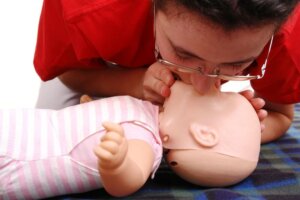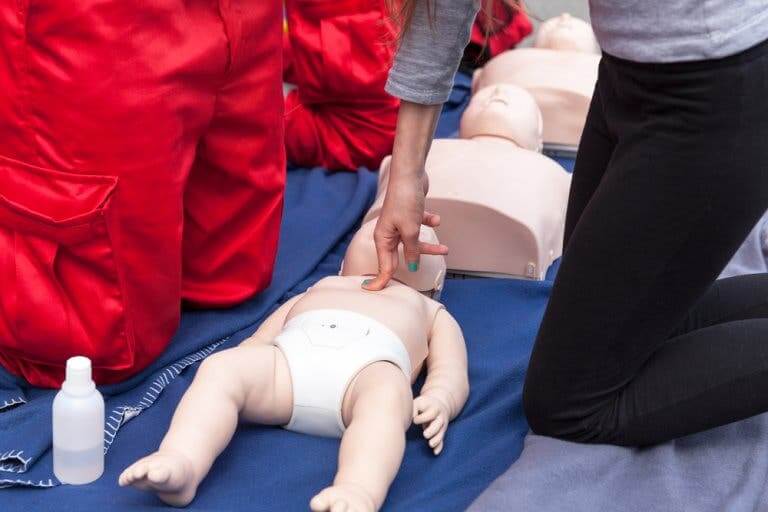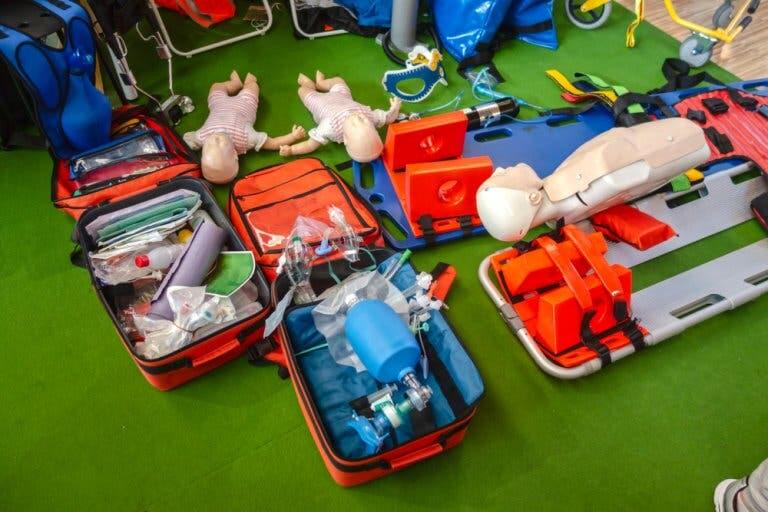CPR in Babies and Infants: What You Should Know

CPR in babies and infants is an emergency procedure that’s performed when the child isn’t breathing or their heartbeat has stopped. This can occur after choking, asphyxiation, as well as in the case of severe respiratory infections or other health problems.
CPR in babies: what is it?
CPR, which stands for cardiopulmonary resuscitation, consists of mouth-to-mouth resuscitation on an infant, bringing oxygen into the lungs, and heart compressions, which keep the blood circulating.
If a baby’s blood circulation stops, permanent brain damage or death can occur within minutes. Therefore, these procedures must be continued until the baby’s heartbeat and breathing return, or until trained personnel arrive.
Who can perform CPR?
The ideal people to perform CPR in babies and infants are those who have received specific training. The latest techniques place more emphasis on heart compressions than on mouth-to-mouth resuscitation, which will require a person to update their training in some way.
Here are some of the official recommendations for you.

To keep in mind
It’s strongly recommended that parents and caregivers learn infant and child CPR techniques. In general, training is widely available and is organized by Scientific Societies, Civil Society Organizations and the State itself.
Factors to consider
Time is very important when dealing with an unconscious child who isn’t breathing. Permanent brain damage begins after only 4 minutes without oxygen. Death may occur 4-6 minutes later.
When CPR is needed for infants
There are many situations that can cause a baby or infant’s heartbeat and breathing to stop. Among them are:
- Asphyxiation
- Choking
- Electric shock
- Excessive bleeding
- Head trauma or other serious injuries
- Lung disease
- Intoxication
- Choking sensation
Symptoms
CPR should be performed if the baby has the following symptoms:
- Respiratory arrest
- No pulse
- Loss of consciousness

What should we do first?
- Try to keep calm despite the stressful situation.
- Check to see if the baby is conscious.
- If there’s no response, then quickly seek help. Make sure you know the emergency numbers and, in the case of schools, and public and private institutions, etc., the numbers must be visible. You should never leave the child alone.
- Carefully place the baby on their back.
- Observe, listen, and feel to see if the child is breathing, watching out for chest movements.
In this article, we won’t be attempting to teach you how to carry out CPR, as this requires specialized treatment. We simply want to warn you about the importance of the first measures that you must put into practice, and about acquiring training if you haven’t already done this.
Prevention
Most children who need CPR have suffered some sort of preventable accident. The following tips may help prevent some of these accidents:
- Never leave a baby alone on a bed, table, or any surface where they can roll around.
- Always use safety belts on high chairs and strollers. Follow the safety instructions on car seats.
- Teach your child the meaning of “don’t touch.” The first safety lesson is “No!”
- Select toys that are appropriate for the child’s age. Don’t give babies or infants heavy or fragile toys.
- Inspect toys for loose or small parts, sharp edges, spikes, loose batteries, or other hazards, and even more so when older siblings are in the house.
- Keep toxic cleaning materials stored safely in cabinets that are inaccessible to children and that contain their original labeled containers.
- To reduce the risk of choking accidents, make sure that infants and young children can’t reach buttons, watch batteries, popcorn, coins, grapes, or nuts.
- Sit with the baby when you’re eating. Don’t allow them to crawl while eating or drinking from a bottle.
The bottom line on infant CPR
- Never underestimate what a child can do. Assume your baby can move more than you think.
- Create a safe environment. Supervise children carefully, particularly around water and near furniture.
- Don’t tie pacifiers, jewelry, chains, bracelets, or any other objects around the baby’s neck or wrists.
CPR in babies and infants is an emergency procedure that’s performed when the child isn’t breathing or their heartbeat has stopped. This can occur after choking, asphyxiation, as well as in the case of severe respiratory infections or other health problems.
CPR in babies: what is it?
CPR, which stands for cardiopulmonary resuscitation, consists of mouth-to-mouth resuscitation on an infant, bringing oxygen into the lungs, and heart compressions, which keep the blood circulating.
If a baby’s blood circulation stops, permanent brain damage or death can occur within minutes. Therefore, these procedures must be continued until the baby’s heartbeat and breathing return, or until trained personnel arrive.
Who can perform CPR?
The ideal people to perform CPR in babies and infants are those who have received specific training. The latest techniques place more emphasis on heart compressions than on mouth-to-mouth resuscitation, which will require a person to update their training in some way.
Here are some of the official recommendations for you.

To keep in mind
It’s strongly recommended that parents and caregivers learn infant and child CPR techniques. In general, training is widely available and is organized by Scientific Societies, Civil Society Organizations and the State itself.
Factors to consider
Time is very important when dealing with an unconscious child who isn’t breathing. Permanent brain damage begins after only 4 minutes without oxygen. Death may occur 4-6 minutes later.
When CPR is needed for infants
There are many situations that can cause a baby or infant’s heartbeat and breathing to stop. Among them are:
- Asphyxiation
- Choking
- Electric shock
- Excessive bleeding
- Head trauma or other serious injuries
- Lung disease
- Intoxication
- Choking sensation
Symptoms
CPR should be performed if the baby has the following symptoms:
- Respiratory arrest
- No pulse
- Loss of consciousness

What should we do first?
- Try to keep calm despite the stressful situation.
- Check to see if the baby is conscious.
- If there’s no response, then quickly seek help. Make sure you know the emergency numbers and, in the case of schools, and public and private institutions, etc., the numbers must be visible. You should never leave the child alone.
- Carefully place the baby on their back.
- Observe, listen, and feel to see if the child is breathing, watching out for chest movements.
In this article, we won’t be attempting to teach you how to carry out CPR, as this requires specialized treatment. We simply want to warn you about the importance of the first measures that you must put into practice, and about acquiring training if you haven’t already done this.
Prevention
Most children who need CPR have suffered some sort of preventable accident. The following tips may help prevent some of these accidents:
- Never leave a baby alone on a bed, table, or any surface where they can roll around.
- Always use safety belts on high chairs and strollers. Follow the safety instructions on car seats.
- Teach your child the meaning of “don’t touch.” The first safety lesson is “No!”
- Select toys that are appropriate for the child’s age. Don’t give babies or infants heavy or fragile toys.
- Inspect toys for loose or small parts, sharp edges, spikes, loose batteries, or other hazards, and even more so when older siblings are in the house.
- Keep toxic cleaning materials stored safely in cabinets that are inaccessible to children and that contain their original labeled containers.
- To reduce the risk of choking accidents, make sure that infants and young children can’t reach buttons, watch batteries, popcorn, coins, grapes, or nuts.
- Sit with the baby when you’re eating. Don’t allow them to crawl while eating or drinking from a bottle.
The bottom line on infant CPR
- Never underestimate what a child can do. Assume your baby can move more than you think.
- Create a safe environment. Supervise children carefully, particularly around water and near furniture.
- Don’t tie pacifiers, jewelry, chains, bracelets, or any other objects around the baby’s neck or wrists.
All cited sources were thoroughly reviewed by our team to ensure their quality, reliability, currency, and validity. The bibliography of this article was considered reliable and of academic or scientific accuracy.
- medlineplus.gov. Medline Plus, Biblioteca Nacional de Medicina, EE.UU. www.medlineplus.gov/
- Sociedad Argentina de Pediatría. (2013). Recomendaciones de Reanimación Pediátrica, Comité Nacional de Emergencias y Cuidados Críticos Programa de Emergencias y Reanimación Avanzada (E.R.A).
This text is provided for informational purposes only and does not replace consultation with a professional. If in doubt, consult your specialist.








